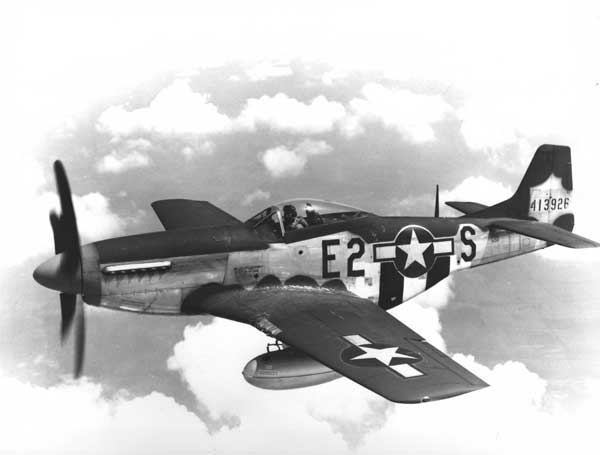The U.S. Air Force officially named the F-16 “Fighting Falcon” on July 21st, 1980, during a ceremony at Hill AFB in Utah.
The F-16 Fighting Falcon is a compact, multi-role fighter aircraft. In the air combat role, the F-16’s maneuverability and combat radius exceed that of all potential enemy fighter aircraft. It can locate targets in all weather conditions and detect low flying aircraft in radar ground clutter. In the air-to-surface role, the F-16 can fly over 500 miles, deliver its weapons accurately, defend itself, and return to base. An all-weather capability allows it to accurately deliver ordnance during bad weather or at night. With a full load of internal fuel the F-16 can withstand up to 9G’s, it’s likely the pilot will fail before the airframe does.. The bubble cockpit canopy gives the pilot unobstructed vision forward and upward and much improved vision over the side and rear.

General Dynamics F-16 Fighting Falcon
U.S. Air Force F-16C Fighting Falcons from the 457th Fighter Squadron, 301st Fighter Wing, Naval Air Station Joint Reserve Base Fort Worth, Texas, conduct tactical training over Texas on February 7, 2006. (U.S. Air Force photo by Staff Sgt. Jacob N. Bailey) (Released)

General Dynamics F-16 Fighting Falcon
MOUNTAIN HOME AIR FORCE BASE, Idaho -- Capt. Christopher Stricklin ejects from the USAF Thunderbirds number six aircraft less than a second before it impacted the ground at an air show at Mountain Home Air Force Base, Idaho, Sept. 14. Stricklin, who was not injured, ejected after both guiding the jet away from the crowd of more than 60,000 people and ensuring he couldn't save the aircraft. This was only the second crash since the Air Force began using F-16 Falcons for its demonstration team in 1982. The ACES II ejection seat performed flawlessly. (U.S. Air Force photo by Staff Sgt. Bennie J. Davis III)
The F-16 first flew in December 1976. The first operational F-16A was delivered to the 388th TFW at Hill AFB, Utah in January 1979. The two-seat version, the F-16B, has two cockpits each about the same size as the single ‘A’ version cockpit. To make room for the second cockpit the forward fuselage fuel tank and avionics growth space is reduced.
The Falcon was one of the first to use the now standard fly-by-wire control system whereby no direct mechanical link is provided, instead the pilot’s controls communicate with the F-16 ‘s electronics which in turn move the aircraft’s flying surfaces. This system requires a side-mounted control stick instead of the conventional between the knees joystick that came as standard with combat planes since the beginning, needed for better control during the high-G maneuvers the plane can fly.
To simplify and cut the cost of development and production of the Falcon, some existing and proven systems from other USAF aircraft were adapted for it’s use. Parts used in the earlier F15 Eagle and the old swing wing F111 fighter bomber found a home in the aircraft. Unusually the F16 Falcon has a single engine instead of two. While cutting the cost of the aircraft and also maintenance time it does always increase the chance of a ‘dead stick landing’, however the F16 has proven reliable in the field.
The Lockheed Martin F-16 Fighting Falcon, the first of the US Air Force multi-role fighter aircraft, is the world’s most prolific fighter with more than 2,000 in service with the USAF and 2,000 operational with 23 other countries.
Specifications
Primary Function Multi-role fighter
Builder Lockheed Martin Corp.
Power Plant F-16C/D:
one Pratt and Whitney F100-PW-200/220/229 or
one General Electric F110-GE-100/129
Thrust F-16C/D, 27,000 pounds(12,150 kilograms)
Length 49 feet, 5 inches (14.8 meters)
Height 16 feet (4.8 meters)
Wingspan 32 feet, 8 inches (9.8 meters)
Speed 1,500 mph (Mach 2 at altitude)
Ceiling Above 50,000 feet (15 kilometers)
Maximum Takeoff Weight 37,500 pounds (16,875 kilograms)
Combat Radius [F-16C]
740 nm (1,370 km) with 2 2,000-lb bombs + 2 AIM-9 + 1,040 US gal external tanks
340 nm (630 km) with 4 2,000-lb bombs + 2 AIM-9 + 340 US gal external tanks
200 nm (370 km) + 2 hr 10 min patrol with 2 AIM-7 + 2 AIM-9 + 1,040 US gal external tanks
Range Over 2,100 nm (2,425 mi; 3,900 km)
Armament One M-61A1 20mm multibarrel cannon with 500 rounds; external stations can carry up to six air-to-air missiles, conventional air-to-air and air-to-surface munitions and electronic countermeasure pods.




























